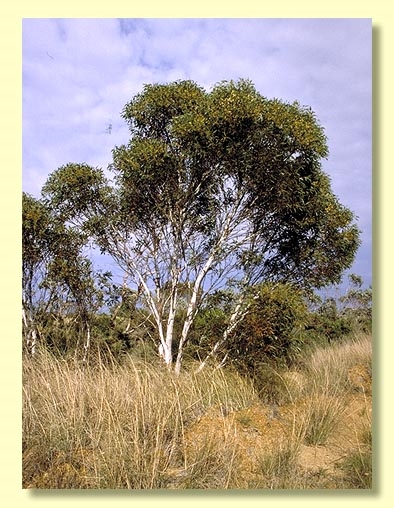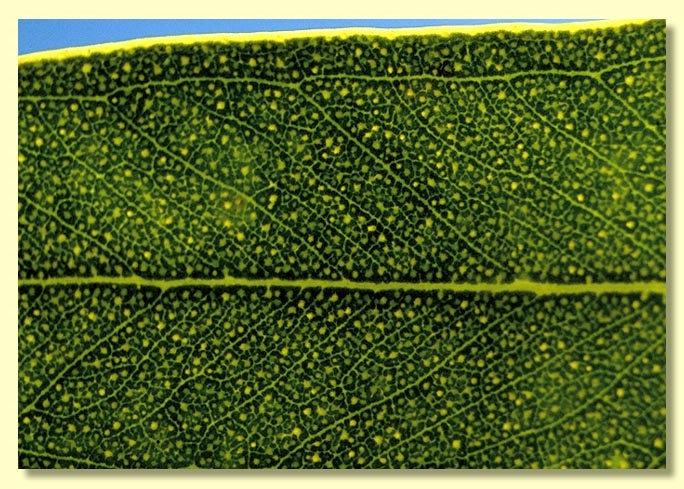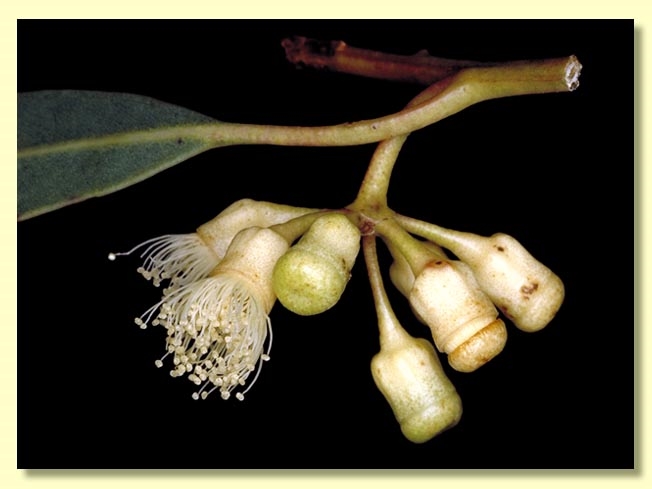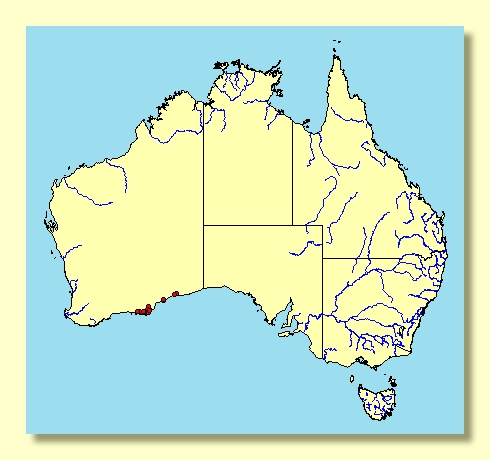Eucalyptus | Symphyomyrtus | Bisectae | Destitutae | Cooperianae
Euclid - Online edition
Eucalyptus cooperiana
Bark smooth throughout or with some persistent flaky-fibrous rough grey bark at the base of the stem, smooth bark powdery white over pale grey to pinkish grey.
Branchlets lacking oil glands in the pith.
Juvenile growth (coppice or wild seedling to 50 cm tall): stems rounded in cross-section; juvenile leaves opposite and sessile for many pairs then becoming alternate, shortly petiolate, elliptical to ovate, 3.5–10 cm long, 2.5–6 cm wide, dull grey-green.
Adult leaves alternate, petioles 1.3–2.8 cm long; blade lanceolate, (5.8)6.5–10.5(11) cm long, 1–2.5 cm wide, base tapering to petiole, margin entire, apex acute, concolorous, glossy, green or sometimes bluish green, side-veins at an acute or wider angle to midrib, reticulation dense, intramarginal vein remote from margin, oil glands scattered, irregular, intersectional.
Inflorescence axillary unbranched, peduncles spreading to down-turned, 0.7–1.8 cm long, buds 9, 11 or 13 per umbel, pedicellate (pedicels 0.4–0.9 cm long). Mature buds ovoid or cylindrical (0.6–1.1 cm long, 0.4–0.5 cm wide), creamy white (not glaucous), scar present (outer operculum shed early), operculum flattened to rounded, rarely obtusely conical, hypanthium usually with about 10–12 shallow longitudinal ribs, sometimes the ribs absent, stamens inflexed, anthers more or less oblong, versatile, sub-basifixed, dehiscing by lateral slits, style long and straight, stigma blunt, locules 3 or 4, the placentae each with 4 vertical rows of ovules. Flowers cream-yellow.
Fruit often on down-turned peduncles, pedicellate (pedicels 0.4–0.7 cm long), urceolate, 0.5–1 cm long, (0.6)0.7–0.9 cm wide, disc vertically descending, valves 3 or 4, enclosed.
Seeds grey-brown, 1–2.5 mm long, flattened-ovoid, dorsal surface more or less smooth, hilum ventral.
Cultivated seedlings (measured at ca node 10): cotyledons Y-shaped (bisected); stems rounded in cross-section, smooth or slightly warty; leaves sessile, opposite for at least 15 nodes, linear for the first few nodes then narrowly elliptic to elliptic or ovate, sometimes more or less orbicular, 1.8–3 cm long, 0.5–1.5 cm wide, dull, grey-green. Leaves become shortly petiolate after ca node 15–18.
Flowering has been recorded in April, June, September and November.
A mallee endemic to Western Australia, found only east of Esperance towards Israelite Bay, Toolinna Cove and Eyre. The bark is smooth, usually white and powdery, adult leaves glossy green and the cream flat-topped buds are constricted below the join of operculum and hypanthium.
Eucalyptus cooperiana belongs in Eucalyptus subgenus Symphyomyrtus section Bisectae subsection Destitutae because buds have two opercula, cotyledons are Y-shaped and branchlets lack oil glands in the pith. Within this subsection however E. cooperiana is not closely related to any other species, forming the monotypic series Cooperianae. Its urceolate fruit suggest a relationship with E. flocktoniae although it does not share the decurrent seedling leaves of this species.
The combination of pendulous blunt buds, urceolate fruit and seasonally powdery bark makes E. cooperiana easily recognisable within its home range.













